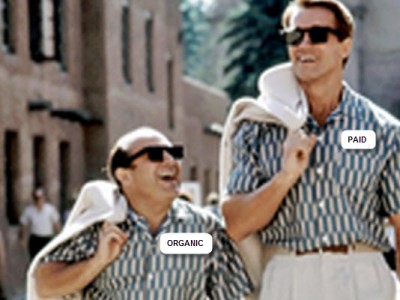It just got a lot easier to track, analyze and understand the relationship between PPC ads and organic listings on Google’s search engine results pages (SERPs).
Google Adwords’ new report, called the “Paid and Organic ” report, provides comparative analysis of visitor traffic and click through behavior on Google search engine results pages for the following three scenarios:
1) When your PPC ad appears alone on a SERP
2) When your organic listing appears alone on a SERP
3) When your PPC and your organic listing appear together on a SERP
In the past, info in this report was available separately through Google Adwords and Google Analytics. Now they are neatly organized together. It also provides an additional layer of detail that confirms whether your PPC ad or organic listing is appearing alone or together on the SERP, along with the associated visitor click through outcomes for each scenario.
So, here’s what the report looks like:
In this specific example, the traffic numbers are low, so statistically they’re not providing any deep insights but they do cleanly demonstrate how the numbers work on the report. We’ve only recently set up this report for a number of our accounts so it will take a while for data to populate the report to become more useful with deeper insights.

PRACTICAL TIP: Activate this report in your Adwords Account now! You want data on your fall recruitment campaigns to begin to collect in this report. If you wait to activate the report later when you need it, you will be deeply disappointed that there is no historical data and kick yourself for not heeding my words now!
Activating this Adwords report requires a couple of steps including 1) linking your Google Analytics account to Webmaster Tools and then 2) give the report permission to collect the data. See this Google post for more info about setting up this report.
There are a number of ways this report can provide valuable information:
1) Identify high performing organic search keywords for use in your PPC campaigns. Yes, there are other ways to do this but this report makes is really easy and provides that new insight into what is happening with them right up next to your PPC stats.
2) Identify high performing PPC keywords that you should be optimizing you site for with on-page SEO. It is very easy for your PPC campaigns to get our ahead of your on-page SEO in terms of keyword priorities. This report will show you if that’s happening and where to spend some time and energy to get your on-page SEO current.
3) Research indicates that “the sum of the parts is greater than the whole”, when you combine organic and paid search. Using this report you can manage your organic/paid search ecosystem more holistically and produce better combined paid/organic search campaigns. (I think this will be the true test of this report’s merit. We will get back to you on this with future posts to discuss our own results on this front once we see them.)
In higher ed I think this report will be particularly useful examining the ROI on program and department level recruitment campaigns. For example, think MBA (or other professional program) marketing where PPC advertising is used heavily, often combining branded and department or program related keywords. The Paid and Organic Search Report will allow marketers to closely monitor standalone and combined listing’s performance. As ad position is also provided on the PPC side of the stats, it will also be possible to experiment with PPC ad position as a tool to maximize your lead generation performance vs. your organic rankings. (i.e. if you rank #1 organically for a branded term, maybe you want to be in position #3 for your PPC ad for that keyword, versus PPC ad position #1 if your rank as #4 organically.)
I’ve argued many times on this blog for higher ed marketers to try hard to integrate their thinking on PPC and SEO. This is a great tool to help do that. In many colleges and universities today, PPC advertising and organic search (SEO) are managed quite separately and seen as very different and unrelated tasks. They are very different but they are closely related. This new report helps highlight this reality. With time, (and a chance to build up more visitor data), this report will help us to understand more about visitor dynamics on search engine results pages and how to better integrate PPC campaigns and organic SEO for maximum marketing ROI.
What has your experience been to date in combining your PPC and organic search strategies? Any lessons learned you would like to share?







